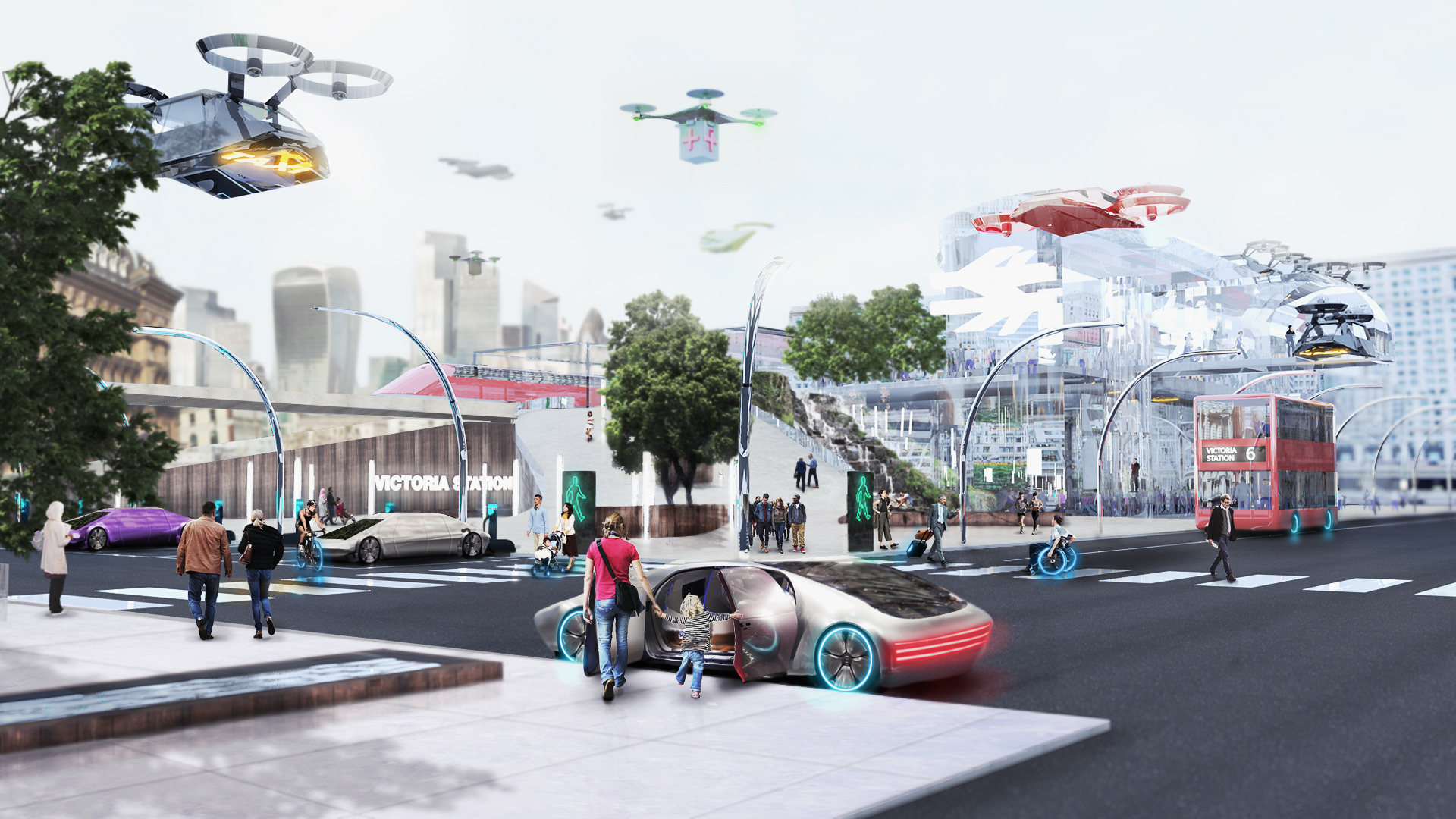By 2050, the transport infrastructure of the UK will have undergone huge developments. UK Research & Innovation (UKRI) through the Industrial Strategy Challenge Fund is helping to fund and support these changes, which will help make everyday lives exponentially better by creating benefits such as improved air quality, reduced traffic, and faster and smoother journeys.
The Future of Aviation
The Future Flight challenge, delivered by UKRI, is supporting the development of new technologies, including ground infrastructure, regulation and control systems, required to use urban aircraft practically and safely. These new modes of travel will increase mobility, reduce road congestion, improve connectivity, increase UK manufacturing opportunities and help aviation to reduce its environmental impact around the world.
In 2050, we will see an integrated, sustainable transport system that will enable a full-scale adoption of future flight vehicle classes into rural regions as well as dense cities and the provision of a wide range of aviation services. The Future Flight challenge is designed to accelerate the use of on-demand aviation whilst helping reduce the 6% of total UK emissions currently accounted for by aviation. It is anticipated that low volume electric ‘air taxis’ will appear in our skies from 2025 and become more commonplace in both cities and rural areas within 10 years. These will develop in size and capability offering the prospect of vertical take-off regional aircraft eliminating travel to airports and slashing journey times. By 2050 we could see all UK regional aircraft using electric power and interconnecting with hydrogen or sustainable fuel aircraft for longer range international travel.
Freight-carrying electric drones will adorn the skies to deliver smaller packages. Such innovations could address the mobility and congestion problems faced by increasingly urban populations, and reduce the carbon footprint of the global aviation system. Such concepts are surprisingly close for smaller packages; UKRI is funding projects aiming to prove the way by 2022 and scale up soon after. Early applications include medical services and other ‘blue-light’ support. Larger delivery vehicles will follow allowing for faster, more frequent deliveries befitting both consumers and industry supply chains.
The Road To Electrification
By 2030 electric vehicles (EVs) will be the norm. However, the next stage is how to reuse and recycle EV batteries, otherwise 6 million EV batteries will be in landfill by 2040. A Faraday Battery challenge winning project, called VALUABLE, is developing ways to reuse, remanufacture, or recycle batteries for solar, wind, rail and marine technologies here in the UK.
Faster charging points will make it easier to charge up electric vehicle batteries, which currently take up five hours to fully charge, or even longer if at home. Solid-state battery specialists Ilika Technologies are working on a project to produce battery technology that can charge an electric vehicle in 25 minutes. Improving the energy density of batteries increases the range for a given battery size, or a smaller battery can be used to provide the same range with lower cost and weight. Ilika, in partnership with The PowerDrive Line, are focussing on developing solid state cells with higher energy density and safety, for a lower cost.
Power electronics, electric machines and drives (PEMD) are inside everything from vacuum cleaners and electric bikes, to planes and wind turbines, it doesn’t matter if the energy comes from the grid, a battery or a fuel cell. The central purpose of the Driving the Electric Revolution challenge is to aid the UK’s move towards electrification by investing in the core PEMD technologies which support it. Transport (by road, rail, air or sea) remains the largest source of carbon emissions in the UK, accounting for 34% in 2019. The UK has pledged to reach net zero by 2050, and this is not possible without advances in PEMD. Furthermore, without this challenge, PEMD development and manufacturing will not happen at scale in the UK, meaning we will be reliant on imports.
Innovations in Public Transport
Public transport, including buses and trains will also be electrified. The electrification of road and rail networks will dramatically reduce carbon emissions and other pollutants.
The braking force required to stop trains and buses at each stop will be converted back into stored energy using PEMD for regenerative braking, allowing the energy to be used again instead of wasted as heat. Adding to this efficiency benefit, there will be a reduction in harmful particulate matter pollution emitted by the conventional friction brakes as they are used less.
Charging points and rail networks will have power supplied from renewable energy sources such as wind, tidal and solar, with PEMD critical to both creating the energy and converting the energy into the motion required to move people and goods around.
Fewer components and moving parts in electrified transport systems means less planned maintenance will be required and fewer breakdowns will occur. The drivetrain of an internal combustion engine vehicle typically contains over 2,000 moving parts, compared to 20 in an electric vehicle.
The sounds associated with life in urban areas will transform as electrified vehicles including buses, trains and construction equipment, that currently dominate the background noise in our cities, will be able to operate more quietly and discretely.

